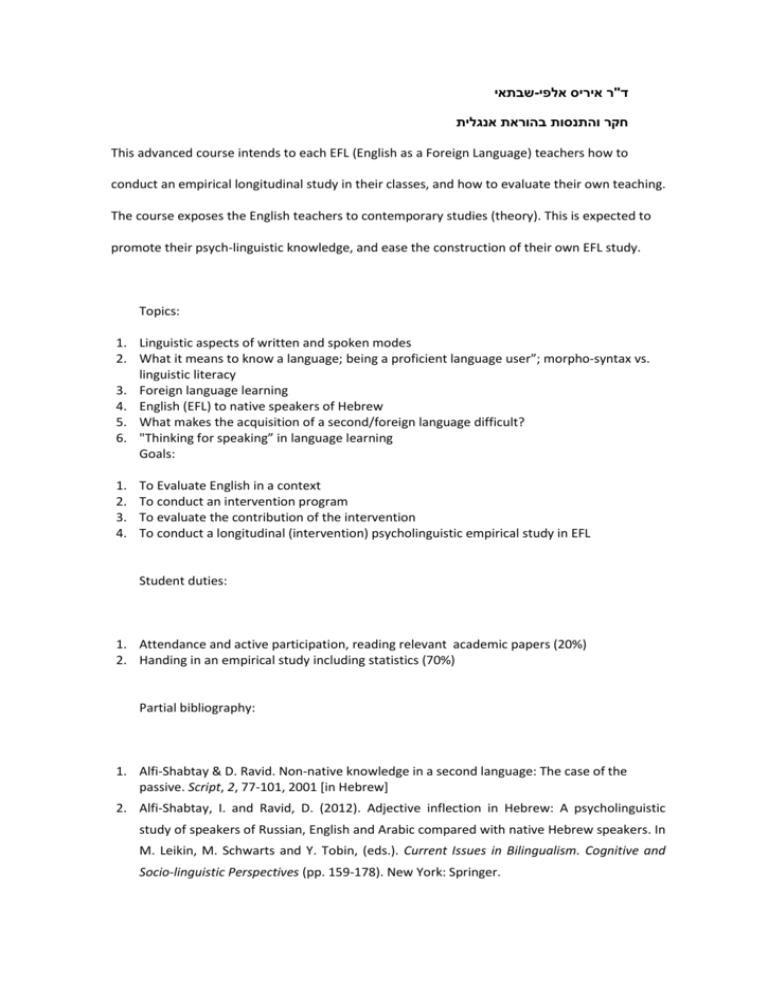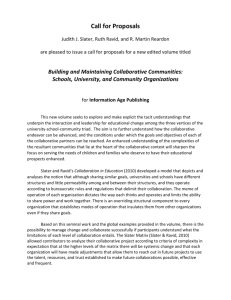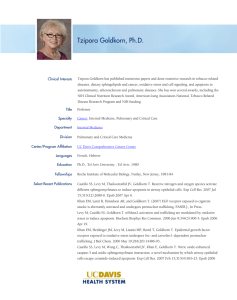ד"ר איריס אלפי-שבתאי חקר והתנסות בהוראת אנגלית This advanced
advertisement

שבתאי-ד"ר איריס אלפי חקר והתנסות בהוראת אנגלית This advanced course intends to each EFL (English as a Foreign Language) teachers how to conduct an empirical longitudinal study in their classes, and how to evaluate their own teaching. The course exposes the English teachers to contemporary studies (theory). This is expected to promote their psych-linguistic knowledge, and ease the construction of their own EFL study. Topics: 1. Linguistic aspects of written and spoken modes 2. What it means to know a language; being a proficient language user”; morpho-syntax vs. linguistic literacy 3. Foreign language learning 4. English (EFL) to native speakers of Hebrew 5. What makes the acquisition of a second/foreign language difficult? 6. "Thinking for speaking” in language learning Goals: 1. 2. 3. 4. To Evaluate English in a context To conduct an intervention program To evaluate the contribution of the intervention To conduct a longitudinal (intervention) psycholinguistic empirical study in EFL Student duties: 1. Attendance and active participation, reading relevant academic papers (20%) 2. Handing in an empirical study including statistics (70%) Partial bibliography: 1. Alfi-Shabtay & D. Ravid. Non-native knowledge in a second language: The case of the passive. Script, 2, 77-101, 2001 [in Hebrew] 2. Alfi-Shabtay, I. and Ravid, D. (2012). Adjective inflection in Hebrew: A psycholinguistic study of speakers of Russian, English and Arabic compared with native Hebrew speakers. In M. Leikin, M. Schwarts and Y. Tobin, (eds.). Current Issues in Bilingualism. Cognitive and Socio-linguistic Perspectives (pp. 159-178). New York: Springer. 3. Berman, R. A., & Slobin, I. D. (1994). Relating Events in Narrative: A Crosslinguistic Developmental Study. Hillsdale, New Jersey: Lawrence Erlbaum Associates, Publishers. 4. Berman, R. A. (1999). Form/Function Relations in Narrative. In A. R. Aisenman (ed.), International Literacy Project Working Papers in Developing Literacy across Genres, Modalities and Languages (Vol. 1, PP. 80-92). Tel Aviv: Tel Aviv University Press. 5. DeKeyser, R. M. (2005). What makes learning second-language grammar difficult? A review of Issues. Language Learning, 55 (S1), 1-25. 6. DeKeyser, R. M., Alfi-Shabtay, I. and Ravid, D. Cross-linguistic evidence for the nature of age effects in second language acquisition. [2010]. Applied Psycholinguistics, volume 31, issue 03, pp. 413-438. 7. Goldfus, C. & Alfi-Shabtay, I. (2007). Developing Language and Literacy in English-Teacher Trainees Following an Intensive Literacy Course: A Longitudinal Study. Final Report. Levinsky College of Education 8. Ravid, D. (2004). Emergence of linguistic complexity in later language development: Evidence from expository text construction. In Ravid, D. & H. Bat-Zeev Shyldkrot (eds.), Perspectives on Language and Language Development (337-355). Dordrecht: Kluwer. 9. Ravid, D. & Tolchinsky, L. (2002). Developing linguistic literacy: A comprehensive model. Journal of Child Language, 29, 419-448. 10. Slobin, D. I. (1996). From “thought and language” to “thinking for speaking”. In Gumperz, J. and Levinson, S. (eds.), Rethinking Linguistic Relativity. Studies in the Social and Cultural Foundations of Language, Volume 17. Cambridge: Cambridge University Press, 70-96.











